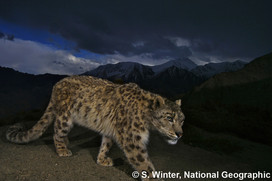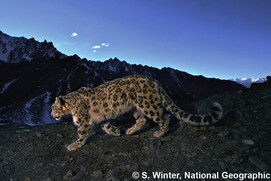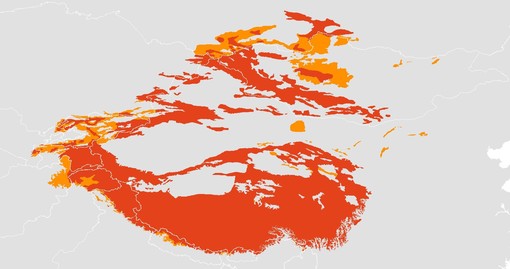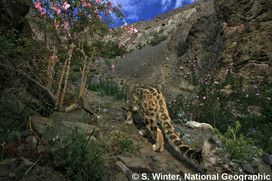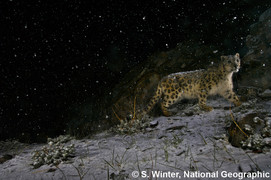Snow leopard
Panthera uncia
IUCN Red List: Vulnerable
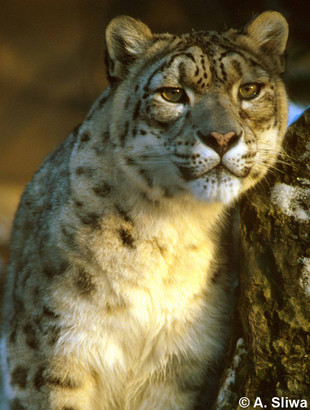
| Weight: | 30-50 kg |
| Body length: | 90-120 cm |
| Tail length: | 80-100 cm |
| Longevity: | 10-20 years |
| Litter size: | 1-5 cubs |

Description
The snow leopard (Panthera uncia) belongs to the genus Panthera and is closely related to the tiger (Panthera tigris). Two subspecies of snow leopard have been described but genetic analysis of intraspecific variation is incomplete and the division of subspecies is still being discussed. On the basis of the available data, the snow leopard is currently recognised as a monotypic species.
The snow leopard has whitish-grey or grey-brown coloured fur with dark grey or black spots and rosettes with pale centres, giving it perfect camouflage for its mountain environment. In winter the fur becomes thick and long (on the belly up to 12 cm) providing protection even in extreme cold conditions. Its head, neck and limbs are black-spotted and two dark lines extend from the neck to the tail. The snow leopard has light green or grey eyes. Its short rounded ears are set wide apart and the backsides of the ears are black with a light centre. The snow leopard is keenly adapted to life at high elevations, with its enlarged nasal cavity, shortened forelimbs and well developed chest muscles. It has long legs and big front paws enabling easier movement in the snow. Its bushy tail is extraordinarily long at up to 1 m or 75-90% of the total body length and is thought to help maintain balance on the steep slopes. They may also use their tail to wrap around themselves for warmth when lying or sitting.
Language/Country | Name |
|---|---|
Afghanistan (Dari) | palang-I-berf |
Bhutan | chen |
Central Asia republics | Irbis, irvis |
China | xue bao |
English | Ounce |
France | panthère des neiges, leopard des neiges, once |
Germany | Schneeleopard, Irbis |
India (Ladakhi; Hindu; Urdu) | shan; bharal he; barfani chita |
Mongolia | Irbis, irvis |
Nepal | hiun chituwa |
Pakistan | Ikar, bharal he, barfani chita |
Russia | Irbis, irvis, snezhnai bars |
Spanish | leopardo nival, pantera de las nieves |
Tibetan | sarken |
Status and Distribution
The snow leopard is listed as Vulnerable on the IUCN Red List. However, no robust estimates of the global snow leopard population exist and past population size estimates are regarded as guesses. Prior to 2003 the population was estimated at 4,080-6,500 and 3,920-6,390 and from 2008-2010 at 4,500-7,500 and 4,678-8,745. Most recently, the snow leopard population was estimated at 7,446-7,996.
Country | Estimated Population Size |
|---|---|
Afghanistan | 50-200 |
Bhutan | 79-112 |
China | 4,500 |
India | 516-524 |
Kazakhstan | 100-120 |
Kyrgyz Republic | 300-350; 350-400 |
Mongolia | 1,000 |
Nepal | 301-400 |
Pakistan | 250 |
Russia | 70-90 |
Tajikistan | 250-280 |
Uzbekistan | 30-50; 80-120 |
The number of mature individuals is estimated at 2,710-3,386. In some parts of its range snow leopard populations are stable or slightly increasing. However, in other areas snow leopard numbers are decreasing and they are locally extinct in some areas of the former Soviet Union. A population decline of 10% over the next 22.62 years (3 generations) is estimated due to exisiting and emerging threats. Estimated snow leopard densities vary between 0.32 to 6.2 individuals/100 km².
The snow leopard’s range includes 12 range states. The snow leopard has probably been extirpated from relatively little of its range, although there are no valid estimates of what constitutes the cat’s historic range. It is restricted to the high mountains of Central Asia including the Altai, Tian Shan, Kun Lun, Pamir, Hindu Kush, Karakorum and Himalayan ranges. In 2008, using an expert knowledge mapping process, the current range of the snow leopard was estimated to be 2,942,584 km² across twelve countries. Of that total, snow leopard occurrence was considered definitive or probable within only 1,208,257 km². Within the balance of its assumed current range, some 1,734,328 km², the cat’s presence is only considered to be ‘possible’, indicating a need for additional surveys over a vast area.
Country | Estimated current range (km²) |
|---|---|
Afghanistan | 14,530 |
Bhutan | 8,761 |
China | 1,897,786 |
India | 123,071 |
Kazakhstan | 31,487 |
Kyrgyzstan | 75,770 |
Mongolia | 342,134 |
Nepal | 21,905 |
Pakistan | 80,686 |
Russia | 78,847 |
Tajikistan | 75,543 |
Uzbekistan | 7,694 |
Habitat
The snow leopard mainly occupies the alpine and subalpine ecological zones where it frequents steep terrain well broken by cliffs, ridges, gullies, and rocky outcrops. However in some parts of Mongolia and on the Tibetan Plateau the snow leopard occurs in relatively less precipitous landscape, especially if there are suitable travel routes along ridges and where sufficient cover is found. Throughout most of its range the snow leopard is associated with arid and semi-arid shrubland, grassland or steppe. In the mountains of Russia and parts of the Tian Shan it occurs in open coniferous forest and generally avoids dense forest. The landscape typically occupied by snow leopards encompasses some of the least productive habitats due to the extreme cold and arid climate. Prey population densities consequently reflect local climatic conditions and are generally low.
The snow leopard is generally found at elevations between 3,000-5,000 m, although it occasionally goes above 5,500 m in the Himalaya; and at the northern limits of its range it can be found in lower elevations of 600-2,500 m. In the Altai it can even occur at 500 m.
Ecology and Behaviour

- Snow leopard marking with urine.
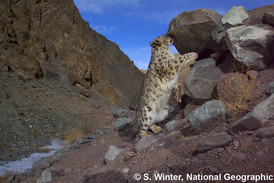
- Snow leopard inspecting a marking site.
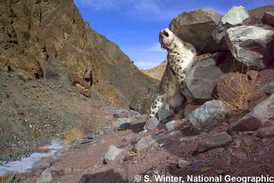
- Snow leopard marking the site by rubbing its head.
The snow leopard is a solitary predator and is mostly active at dusk and dawn. It is well adapted for climbing steep and rocky alpine terrain. The snow leopard occupies large territories with high degree of overlap between and within the sexes. Home ranges of 18 GPS collared snow leopards in the South Gobi in Mongolia ranged from 100 to over 1,000 km² (average for males = 408 km² (n=10) and average for femalse = 308 km² (n=9)). A female in Pakistan used a home range exceeding 1,000 km². In Nepal home ranges of 10-40 km² but also once of over 400 km² were recorded. Home range size may depend on the habitat and prey densities. Recorded daily distances moved in Nepal using ground-based VHF telemetry were up to 7 km, but averaged 1.0 km for males and 1.3 km for females. GPS-collared snow leopards in the South Gobi moved an average of 3.6 km per day for females and 5.8 km per day for males. Males also moved larger distances each day during breeding season, while females moved the same distances each day during breeding season and other times of the year.
Snow leopards communicate mostly through scent marking and scraping. The snow leopard’s vocal fold is less developed than in the other pantherines and lacks a thick pad of fibro-elastic tissue so that it cannot make the low and intense "roars" like other big cats. They do yowl and it is most common during breeding season when seeking a mate. Generally snow leopards tend to move, bed and mark along linear topographic features such as major ridgelines or the base or crest of broken cliffs.
The snow leopard stalks its prey from above, chasing it down steep slopes. The snow leopard is capable of killing prey up to three times its own weight and can remain with a kill up to a week if not disturbed. The average number of days on an ibex kill in Mongolia was 2.59 and ranged from 1 to 11 days (n=140).
Age at sexual maturity is 2-3 years. The reproductive season is in early January to mid-March. Most births occur in May-June. The estrus lasts for 2-12 days, the estrus cycle for 15-39 days and the gestation 98-104 days. At around 18-22 months, cubs begin to disperse. In the early stages of independence, sibling groups may remain together briefly. The record for the oldest reproductive success in captivity is reported to be a 15 years old for a female.
Prey
The snow leopard preys primarily on wild sheep and goats, such as blue sheep (Pseudois nayaur), Siberian ibex (Capra sibirica), markhor (Capra falconeri), argali (Ovis ammon), musk deer (Moschus chrysogaster) and Himalayan tahr (Hemitragus jemlahicus) and the cat’s range closely mirrors that of those wild ungulates. Where available, it may supplement its diet with smaller prey such as marmot (Marmota spp), pika (Ochotona spp.), hare (Lepus spp.), snowcock (Tetraogallus spp.) and chukar partridge (Alectoris chukar). The portion of the diet composed of such small prey has likely been overestimated in previous studies based on ocular examination of purported snow leopard faeces. With the advent of genetic validation of faecal origins, the estimated contribution of small prey to snow leopard diets has been substantially reduced. Domestic livestock is frequently preyed upon and in some areas this can be significant, constituting as much as 70% of the diet, although 15–30% is more common.
Main Threats
Primary threats and extent of threats vary among countries and regions. Generally, the main threats are competition with livestock, habitat degradation, prey declines, retribution killing in retaliation for livestock depredation and poaching for illegal trade (hides, bones and other body parts). Additionally, its habitat is subject to extensive agro-pastoral land use and is degraded and fragmented in some areas.
Mountain ungulates, which are the main prey of snow leopards, are heavily impacted by over-hunting and in some places by competition with livestock for food. A reduced prey base leads to much lower habitat quality for snow leopards. When the natural prey base is low, livestock predation by snow leopards tends to increase. Although in one study, the rate of depredation on livestock was shown to increase as wild prey numbers and snow leopard numbers increased. Livestock populations are locally abundant and can make up more than half of the snow leopard’s diet. Poaching as retribution for livestock predation is one of the most important threats to snow leopards and likely takes place over large areas of its range. Illegal killing for commercial purposes is also still a problem in many parts of its range. Its fur is valuable and body parts (such as bones, claws or meat) are used in traditional medicine partly as substitutes for tiger parts. This illegal trade may be increasing along with China’s rapidly growing economy. The demand for snow leopard products seems to be increasing especially in China and Eastern Europe and snow leopard trade emerged outside of snow leopard range provinces in China. Since 2008, an estimated 221-450 snow leopards were annually poached. It is estiamted that annually 103-236 snow leopards in China, 34-53 in Mongolia, 23-53 in Pakistan, 21-45 in India and 20-25 in Tajikistan are illegally killed. Only around 38% of poaching accidents are detected. Therefore, it is suggested that annually around 2-10% of the population could be poached.
There is also an unspecified level of demand for live animals for zoos and private collections. Human population growth, poverty, the general lack of awareness at both local and national levels for the need to protect the snow leopard, the lack of institutional capacity and law enforcement as well as the limited transboundary collaboration all hinder conservation efforts. Moreover, up to a third of the snow leopard range falls along politically sensitive international borders. Military conflicts are taking place across parts of its range, causing damage to wildlife and threatening conservation. New threats include climate change, mining and large scale infrastructure development. Also diseases threaten the snow leopard.
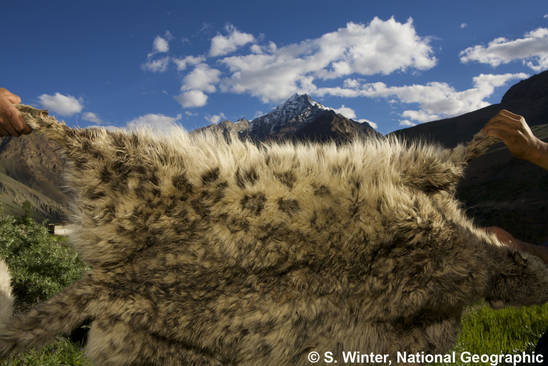
- Snow leopard skin.
Conservation Efforts and Protection Status
The snow leopard is included in Appendix I of CITES and fully protected across all of its range. Conservation actions for the snow leopard include the establishment of new protected areas. About 200 protected areas are thought to contain snow leopards with a combined area in excess of 1.3 million km². However, nearly 40% of the protected areas are less than 500 km² and likely contain only a few breeding pairs. Most are inhabited by people and livestock, and not all have management plans. It is therefore important to improve protected area design and management in respect for the needs of snow leopards, and to enhance snow leopard conservation outside protected areas.
Better grazing management and livestock husbandry, improvement of livestock corals, livestock vaccination, livestock insurance, alternative livelihoods, re-establishment of prey populations, conservation education and community engagement programmes are some of the steps taken to reduce conflicts between local people and snow leopards. Of utmost importance is bringing local people into the process of conserving snow leopards and other wildlife. To reach that goal, more and more international groups are working to reduce poaching and persecution of snow leopards through community-based initiatives that provide an economic incentive to do so. Moreover, training and capacity-building and anti-poaching measures are conducted. Anti-poaching efforts were for example strengthened in Kazakhstan, Kyrgyzstan and Tajikistan and wire-snares were removed and former poachers recruited as protected area rangers in parts of Russia. Incentive programmes and innovative community programmes have been established in several snow leopard range states.
The Snow Leopard Network was established to unite individuals and organisations for better cooperation and information sharing and to help implement the Snow Leopard Survival Strategy. The International Conference on Range-wide Conservation Planning for Snow Leopards held in Beijing in 2008 brought experts together to improve the knowledge base. Important areas for snow leopard conservation were identified and a framework for the development of national action plans was provided. As part of the 2013 Global Snow Leopard Forum in Bishkek, all range countries developed National Snow Leopard Ecosystem Protection Priorities (NSLEP). These are summarised in the Global Snow Leopard Ecosystem Protection Priorities (GSLEP) document. Many of the range countries, as part of their own internal national exercises, have developed official Snow Leopard Action Plans or Strategies. Some have been officially approved, while others have awaited approval for varying lengths of time. Several of these country specific plans are available in the online library of the Snow Leopard Network. Countries with formally adopted action plans include India, Kazakhstan, Kyrgyzstan, Mongolia, Pakistan and Russia, while Tajikistan and Uzbekistan have plans drafted that have yet to be adopted by the government. The Snow Leopard Survival Strategy has been revised. All these activities have improved the strategic framework for the conservation of the snow leopard at a global level.
Beside these efforts, there is still a need for building more conservation capacity, strengthening international cooperation, developing range states' national legislation and improving law enforcement to prohibit killing and trading of snow leopards or their body parts. Detailed information about abundance and status of snow leopards is still limited mostly due to its elusive behaviour, low population densities and rugged mountain habitat difficult to access. Therefore, long-term studies and further investigations are needed.



